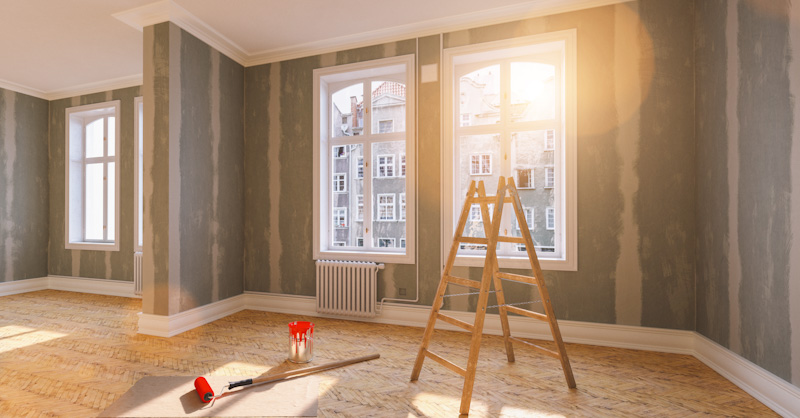Specialist Sheetrock Repair Fort Worth for Quick Fixes
Specialist Sheetrock Repair Fort Worth for Quick Fixes
Blog Article
Drywall Installation Facilitated: Tips for Perfect Outcomes
Drywall installment is commonly viewed as a complicated job, yet with the ideal method and knowledge, it can become a convenient undertaking. Choosing high quality materials and preparing the installment location are important initial steps that establish the foundation for success. Additionally, mastering strategies for cutting, hanging, and finishing drywall can dramatically affect the end result. As we explore these crucial suggestions, you may find that also the smallest changes in your method can lead to extremely improved outcomes, leaving you to think about just how these methods can transform your following project.
Picking the Right Materials
Choosing the ideal materials for drywall setup is crucial to accomplishing a sturdy and aesthetically pleasing surface. drywall installation. The main part, drywall sheets, generally can be found in numerous thicknesses, with 1/2-inch sheets being conventional for indoor wall surfaces. For areas needing extra dampness resistance, such as bathrooms or kitchen areas, think about making use of environment-friendly board or cement board, which are specifically created to hold up against moisture

Additionally, selecting the right bolts-- either nails or screws-- is crucial for safeguarding the drywall to the framework. Drywall screws are normally favored for their holding power and decreased risk of popping. Lastly, take into consideration the complements such as guide and paint, which not only enhance the look yet likewise safeguard the drywall from moisture and wear.
Preparing the Installment Location
Before starting the drywall setup process, it is vital to prepare the installment location extensively. This preparation entails a number of essential actions to guarantee a effective and smooth job. First, clear the location of any type of furniture, devices, or obstructions that can impede access. A clean office reduces the threat of damage to existing things and allows for reliable movement throughout installation.
Next, examine the wall surfaces and ceiling for any flaws, such as splits, openings, or mold. Address these concerns beforehand; patch any kind of damages and allow adequate time for repairs to dry. In addition, ensure that electrical outlets, buttons, and pipes are properly positioned and made up, as this will certainly impact drywall placement.
Consider the environmental conditions as well. A steady temperature and humidity level are important for optimal adhesion and performance of the drywall materials. If necessary, use a dehumidifier or heating unit to create appropriate conditions.
Cutting and Hanging Drywall
The key to reliable drywall installment lies in the precise cutting and hanging of the panels. Use a straight side and an utility knife to score the drywall along your dimensions, then break it along the racked up line for a clean break.

Always work from the top down and entrusted to right, guaranteeing that you keep a staggered pattern to enhance stability. Effectively hanging the drywall sets the structure Website for a smooth coating, ultimately causing superior results in your drywall task.
Insulation and Mudding Techniques
While appropriate cutting and dangling of drywall sets the stage, the next critical step includes grasping taping and mudding strategies to ensure a seamless surface. Insulation is essential for strengthening joints and stopping splits; it involves embedding tape into the applied joint substance (mud) Beginning with her comment is here a top quality fiberglass or paper tape, using the tape over the joint and pushing it right into the damp mud making use of a taping blade, making certain no air bubbles remain.
Once the tape is in place, apply a slim layer of joint substance over the tape, feathering the edges to develop a smooth transition to the drywall surface. Allow this layer to dry completely before sanding it lightly to remove flaws. Repeat this process, applying extra coats of mud as required-- normally a couple of layers-- while gradually widening the application area with each layer to achieve a seamless look.
After the last layer dries out, sand the surface area with a fine-grit sandpaper up until smooth. drywall contractor. Remember to put on a mask throughout fining sand to prevent inhaling dust particles. Mastering these taping and mudding strategies is essential for attaining a professional-quality coating in your drywall setup
Completing Touches for Perfection
Attaining a remarkable drywall setup exceeds taping and mudding; it finishes in the ending up touches that raise the overall look. These last steps are essential in ensuring a professional-grade coating that improves the aesthetic appeals of your space.
Begin by sanding the dried joint substance to create a smooth surface area. Utilize a fine-grit sandpaper and a sanding block or post sander for ideal control. Pay particular interest to edges and edges, as these areas tend to need more thorough work. After fining sand, wipe down the wall surfaces with a moist towel to eliminate any dirt particles, making sure a clean surface area for painting.
Following, apply a guide especially developed for drywall. This action is important, as it assists secure the joint compound and supplies a consistent base for the topcoat. When the guide dries, inspect for any kind of imperfections, and retouch as required.
Conclusion
In final thought, successful drywall setup pivots on the cautious option of products, detailed prep work of the installation location, and precise execution of reducing and hanging techniques. Proficiency of taping and mudding procedures is essential for achieving a smooth coating.
Drywall installment is often perceived as a challenging task, yet with the right approach and knowledge, it can come to be a convenient undertaking.Picking the proper materials for drywall installation is essential to achieving a durable and cosmetically pleasing coating.Before beginning the drywall installment procedure, it is necessary to prepare the setup area extensively. Understanding these taping and mudding methods is crucial for achieving a professional-quality coating in your drywall setup.
In conclusion, effective drywall setup hinges on the mindful choice of materials, thorough prep work of the installation location, and exact execution of reducing and hanging methods.
Report this page